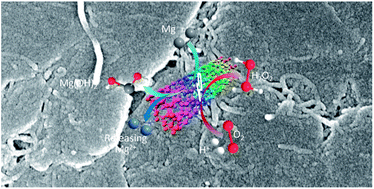Efficient in situ generation of H2O2 by novel magnesium–carbon nanotube composites†
Abstract
Hydrogen peroxide (H2O2) is widely employed as an environmentally friendly chemical oxidant and an energy source. In this study, a novel magnesium–carbon nanotube composite was prepared by a ball milling process in argon atmosphere using polyvinylidene fluoride (PVDF) as a binder. The resulting material was then tested for the in situ generation of H2O2. The preparation and operation conditions of the composite were systemically investigated and analyzed to improve the efficiency of the in situ generation of H2O2. Under the optimized conditions, while aerating with oxygen for 60 min, a maximum H2O2 concentration of 194.73 mg L−1 was achieved by the Mg–CNTs composite prepared using Mg : CNT : PVDF with a weight ratio of 5 : 1 : 2.4. In the Mg–CNTs/O2 system, dissolved oxygen molecules were reduced to H2O2, while magnesium was oxidized owing to the electrochemical corrosion. In addition, a part of dissolved magnesium ions converted into magnesium hydroxide and precipitated as nanoflakes on the surfaces of CNTs. A mechanism was proposed, suggesting that the formation of a magnesium/carbon nanotubes corrosion cell on the Mg–CNT composite promoted the in situ synthesis of H2O2. Overall, this study provides a promising and environmentally friendly strategy to fabricate magnesium/CNT composites for the in situ generation of H2O2, which could be applied in energy conversion and advanced oxidation processes for refractory wastewater treatment.



 Please wait while we load your content...
Please wait while we load your content...